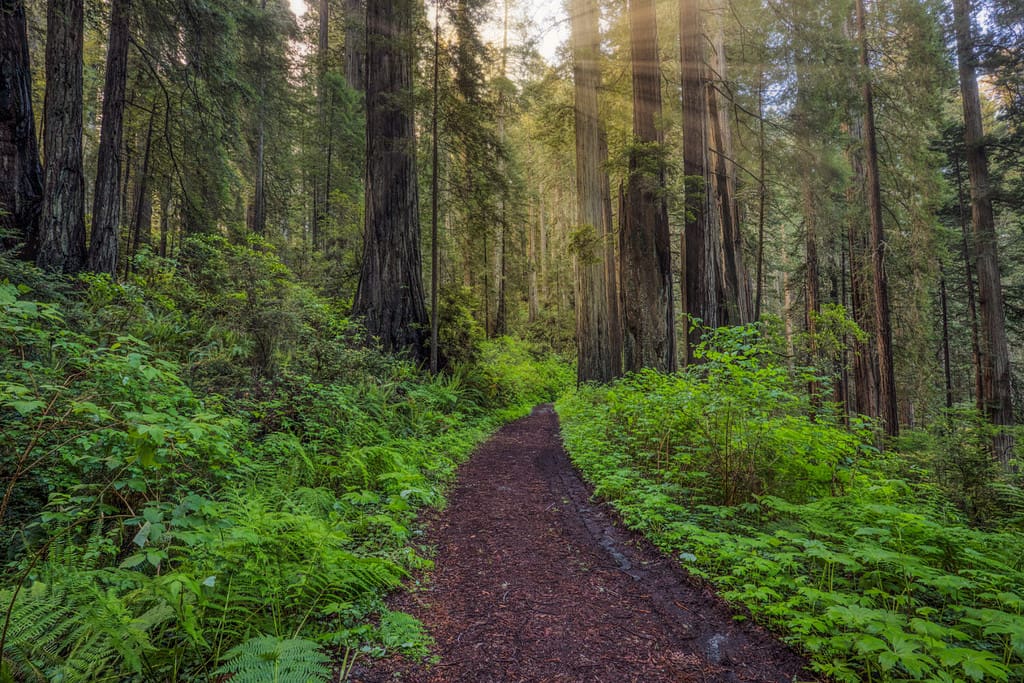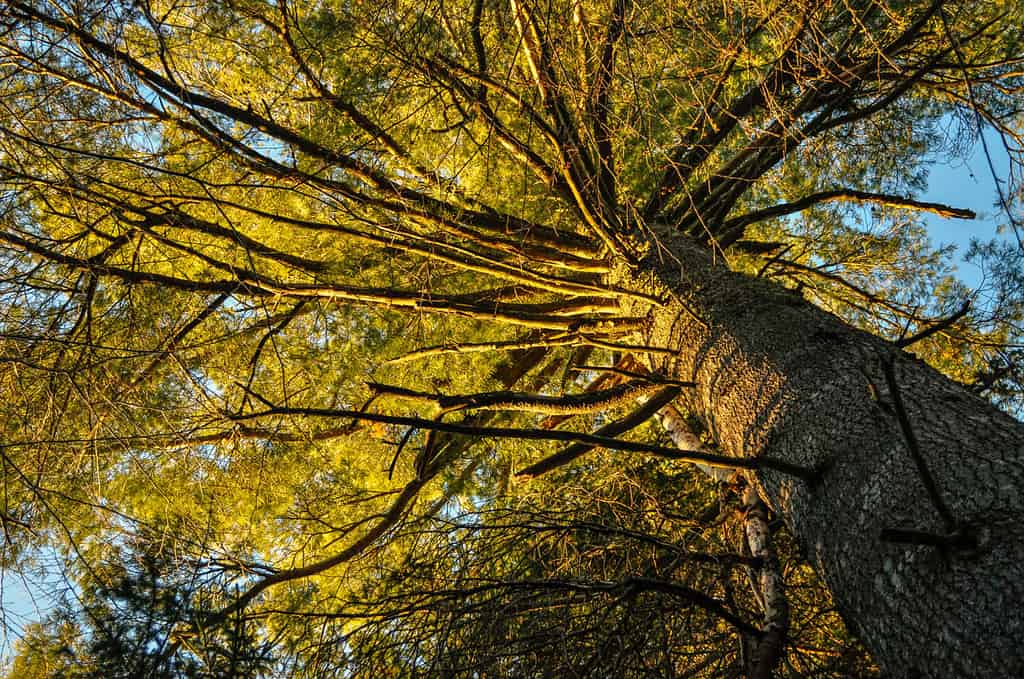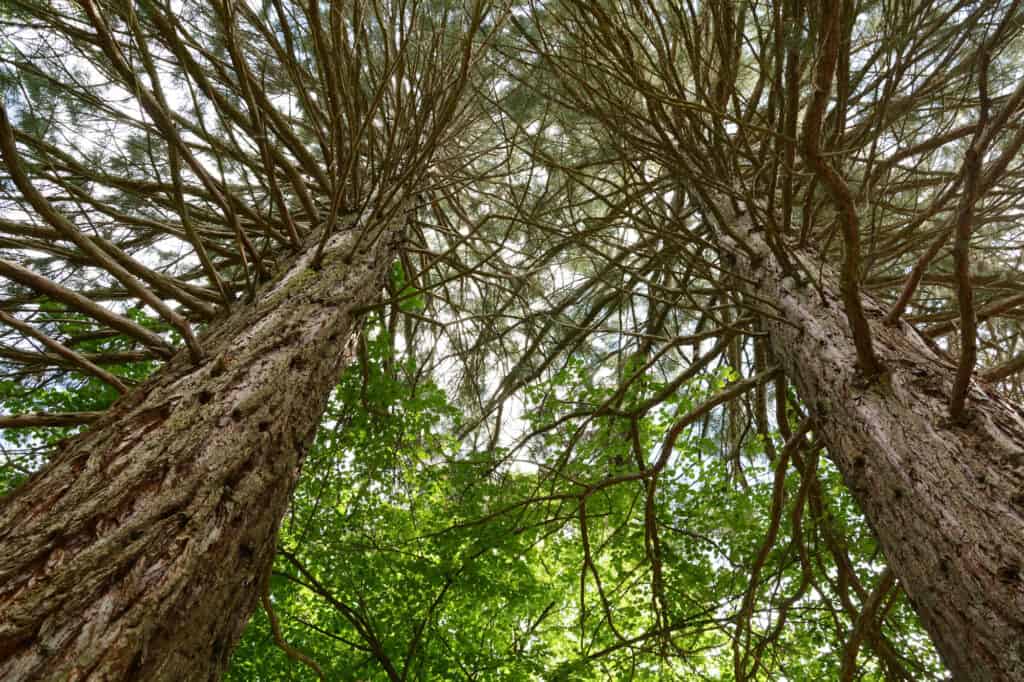Redwood vs. White Pine Tree: 9 Differences Between These Towering Giants
In the towering world of trees, two giants stand tall, each with its own unique charm and characteristics: the mighty redwoods and the graceful white pines. These arboreal titans, though both part of the forest tapestry, couldn’t be more different.
Redwoods, renowned for their towering presence, are the giants of the West Coast. They reach for the skies in a breathtaking display of nature’s grandeur. With their cinnamon-colored bark and enormous girth, they’re the sentinels of ancient forests, standing proud and tall.
On the other hand, white pines, found predominantly in eastern North America, have a more understated elegance. Their slender trunks and feathery needles create a soft, inviting atmosphere in the woods.
As we delve into the contrasts between these arboreal wonders, we’ll explore their physical attributes, habitats, and ecological roles.
Comparing Redwood vs. White Pine Tree
| Redwood | White Pine | |
|---|---|---|
| Classification | Sequoia sempervirens | Pinus strobus |
| Origin | California, Oregon | United States, Canada |
| Natural Habitat | Pacific slope of California’s coast, southwestern Oregon | Eastern North America |
| USDA Hardiness Zone | 7 through 9 | 4 through 9 |
| Conservation Status | Endangered | Least Concern |
| Size | 380 feet | 200 feet |
| Wood Quality | Exceptional | Good |
| Uses | Furniture, lumber, construction | Furniture, cabinetry, construction |
Redwood vs. White Pine Tree: What are Redwoods?
Redwoods, scientifically known as Sequoia sempervirens, are among the most magnificent trees on Earth. These towering giants belong to the family Cupressaceae and are classified under the genus Sequoia. They are native to the western coast of North America, primarily found in California and Oregon.
Physical Traits
Redwood trunks are massive, often exceeding 20 feet in diameter, and are covered with reddish-brown, fibrous bark. The leaves of redwoods are needle-like, arranged in flat sprays, and they appear dark green.
Wildlife Dependence
Redwoods play a pivotal role in supporting a diverse range of wildlife. Their immense canopies provide habitat, shelter, and sustenance for numerous species. Various birds, such as marbled murrelets and spotted owls, nest in the tall branches. Mammals like black bears and mountain lions find refuge in the dense redwood forests, while small mammals like squirrels and chipmunks rely on the abundant seeds and cones produced by the trees.
Furthermore, redwood ecosystems host a wealth of insects and invertebrates, crucial components of the food web. Redwoods’ leaf litter and decaying wood contribute to nutrient-rich soil, fostering the growth of ferns, mosses, and other understory plants.

©Danita Delimont/Shutterstock.com
Redwood vs. White Pine Tree: What are White Pines?
White pine trees, scientifically known as Pinus strobus, are prominent and valuable members of eastern North American forests. These majestic conifers belong to the genus Pinus and are classified under the family Pinaceae. They hold a unique place in the ecosystem due to their distinctive characteristics and ecological significance.
Physical Traits
White pine trees are recognized by their tall, straight trunks and graceful appearance. The needles of white pine trees are slender and flexible, bundled in clusters of five, and measure between three to five inches in length. The bark of young white pines is smooth and grayish-white, gradually developing ridges and furrows as the tree matures.
Wildlife Dependence
White pine trees play a crucial role in supporting diverse wildlife within their ecosystems. Their canopy provides nesting sites and shelter for various bird species, including the iconic bald eagle. Squirrels, such as the red squirrel and eastern gray squirrel, heavily rely on white pine cones as a primary food source during winter.
The seeds within white pine cones also serve as a vital food source for a range of mammals, including white-tailed deer and red foxes. Additionally, the shade and shelter provided by white pine stands create favorable conditions for a variety of understory plants, which in turn support insects and other invertebrates, contributing to the overall biodiversity of eastern forests.

©Bob Grabowski/Shutterstock.com
The Key Differences Between Redwood vs. White Pine Tree
1. Physical Characteristics
Let’s start by examining the physical characteristics of redwoods and white pine trees. These differences extend beyond mere appearances and play a significant role in their ecological roles and adaptability.
Redwoods: The Giants of the West
Redwoods, often referred to as the giants of the West Coast, are renowned for their towering heights. They can reach astonishing heights of over 300 feet, making them some of the tallest trees on Earth. These trees are easily recognizable by their massive trunks that can exceed 20 feet in diameter. The bark of redwoods is reddish-brown, fibrous, and can be remarkably thick, offering protection from external threats, including fire.
The leaves of redwoods are needle-like, arranged in flat sprays, and attached directly to the branches. They are dark green in color and provide excellent photosynthetic efficiency. Redwoods reproduce through both seeds and vegetative sprouting, allowing them to adapt to various environmental conditions.
White Pine Trees: Eastern Elegance
White pine trees, on the other hand, exhibit a different kind of elegance. While they are not as massive in terms of height or girth as redwoods, they are still impressive in their own right. White pines typically reach heights ranging from 80 to 100 feet, with straight trunks that are slender in comparison to redwoods. Some specimens have reached well over 200 feet.
White pine trees are characterized by their slender, delicate needles. These needles are typically bundled in clusters of five and are longer than those of redwoods, ranging from three to five inches in length. The bark of white pine trees is grayish-white and smooth when young, becoming furrowed and ridged with age.
2. Geographical Distribution
Geography is a major factor that distinguishes redwoods and white pine trees, as they are native to different regions of North America.
Redwoods: Coastal Giants
Redwoods are primarily found along the western coast of North America, with their natural range extending from southern Oregon down to central California. The cool, humid coastal climate of this region provides an ideal habitat for these towering giants. The combination of abundant rainfall and mild temperatures contributes to the impressive growth of redwoods in this coastal strip.
White Pine Trees: Eastern Woodlands
In contrast, white pines are exclusively found in the eastern United States and Canada. They have a large distribution, spanning from eastern Canada south through the Appalachians and into the Midwest. White pines are incredibly adaptable, and can survive in a wide variety of environments. Because of their versatility, you can find them all across the eastern United States.
3. Ecological Roles
Both redwoods and white pine trees play vital ecological roles within their respective ecosystems.
Redwoods: Ecosystem Engineers
Redwoods are often considered “ecosystem engineers” due to their profound influence on the surrounding environment. Their massive canopies help maintain the forest by blocking the sun, forming their own microclimates, and sucking up moisture from the coastal fog. Many different kinds of birds, animals, and insects rely heavily on the redwood forest for both shelter and food.
Redwoods are able to withstand a major ecological threat in California’s coastal regions because of their thick, fire-resistant bark, which also protects other trees in the area.
White Pine Trees: Forest Builders
White pine trees are similarly important in their eastern habitats. Because of the important function they play in forest ecosystems, they are often referred to as “forest builders.” White pines are a common sight in the upper levels of eastern forest canopies, where they provide shelter and food for a variety of animals.
Because of its ability to hold soil in place and stop erosion, the white pine is an important biological factor in protecting riparian zones and water supplies. Nutrient cycling in forest ecosystems is another way in which these plants contribute to the environment.
4. Cultural and Economic Significance
Redwoods and white pine trees have left their mark on human culture and economies in different ways.
Redwoods: Cultural Icons and Timber
The redwood trees of California are beloved by locals and tourists alike. These giants are revered not just for their stunning aesthetic value, but also as symbols of environmental protection and preservation. Tourists and nature enthusiasts go to protected groves like Muir Woods National Monument to see some of the world’s tallest trees, which may be found among the redwoods.
Redwood trees were historically important to the development of the logging industry in California. While conservation efforts have curbed extensive logging of ancient redwoods, sustainable timber harvesting continues in some areas, contributing to local economies.
White Pine Trees: Timber and Historical Significance
White pine trees have had a profound impact on American history. They played a vital role in early colonial settlements, providing timber for shipbuilding, homes, and other structures. The towering white pines of the eastern forests were highly prized for their straight, tall trunks, which made them ideal for masts on sailing ships.
White pine lumber continues to play an important role in the modern forest products market. White pine’s low weight and straight grain make it useful for many different projects, including building, cabinets, and furniture.
5. Leaves and Needles
Redwoods have needle-like leaves that are flat and arranged in two rows along the branches. These needles are dark green and remain on the tree throughout the year (a.k.a. evergreen).
White pine trees have soft, slender needles that are arranged in bundles of five. These needles are also evergreen but are more delicate in appearance compared to redwood needles.
6. Cone Characteristics
Redwoods produce small, woody cones that are about one inch in size. These cones contain tiny seeds and are often found high in the canopy, which can make them difficult to spot.
White pine trees produce larger cones that can measure 4 to 8 inches in length. These cones are typically more conspicuous and are a key feature for identifying white pine trees.
7. Bark Texture
Redwoods have thick, fibrous, and deeply furrowed bark. This bark texture provides insulation and protection against external elements, including fire.
The bark of white pine trees is smooth when young and becomes rough, ridged, and grayish-white as the tree matures. This bark texture differs significantly from the fibrous bark of redwoods.
8. Growth Rate
Redwoods are known for their relatively fast growth, especially during their early years. They can add substantial height in a short period, which contributes to their impressive stature.
White pine trees have a moderate growth rate. However, it is typically slower than that of redwoods. It takes them more time to grow to their adult height.
9. Climatic Preferences
Redwoods thrive in a cool, coastal climate with mild temperatures and abundant rainfall. They are particularly well-suited to the coastal regions of California and Oregon.
White pine trees are more adaptable to a range of climatic conditions. They are found in both the eastern United States and Canada, where they can endure various temperatures and precipitation levels.
Redwood vs. White Pine Tree Bonus: Have California’s Wildfires Harmed Redwoods?

©Greens and Blues/Shutterstock.com
The redwood forests of California are a sight to behold, but they also serve an important ecological function. There has been growing concern about the fate of these venerable trees as a result of the more destructive wildfires that California has seen in recent years.
Fire-Resistant Adaptations
Redwoods have evolved several adaptations that make them remarkably resilient to wildfires. Their thick, fire-resistant bark and high water content provide protection against flames and scorching heat. Furthermore, redwoods tend to grow in dense groves, reducing the chances of a wildfire consuming an entire stand of these towering trees.
Underground Safety
One of the lesser-known secrets to redwoods’ survival lies beneath the surface. These giants often possess extensive root systems that can extend up to 100 feet from the tree, intertwining with neighboring redwoods. This underground network not only helps them share vital nutrients but also creates a natural firebreak, preventing the spread of wildfires from tree to tree.
Impact of Recent Wildfires
While redwoods are well-adapted to survive wildfires, the increasing frequency and intensity of California’s fires have raised concerns. The fires can still cause harm by scorching the lower branches and foliage, which may weaken the tree’s overall health. Moreover, smoke and ash from wildfires can hinder photosynthesis, reducing a redwood’s ability to produce energy.
Post-Fire Recovery
Despite potential damage, redwoods have shown remarkable resilience. These giants have the ability to resprout from dormant buds, known as epicormic shoots, located beneath their bark. This adaptation allows them to recover and thrive even after severe fire damage.
Human Intervention
To further protect redwoods, conservation efforts have been underway. Firebreaks, controlled burns, and selective tree-thinning have been implemented to reduce the risk of catastrophic wildfires in redwood forests. These strategies aim to mimic the natural fire regime that redwoods have adapted to over millennia.
When it comes down to it, California’s wildfires can indeed harm redwoods by scorching their lower branches and limiting photosynthesis. However, redwoods’ unique adaptations, including fire-resistant bark and underground root systems, enable them to endure and recover from fire damage. Human intervention and conservation efforts play a vital role in safeguarding these iconic trees, ensuring they continue to thrive in California’s diverse ecosystems. While wildfires pose a challenge, the resilience of redwoods and proactive measures provide hope for the continued preservation of these natural wonders.
Conclusion
In summary, redwoods and white pine trees represent two remarkable species of trees, each with its own set of distinctive characteristics, geographical distribution, and ecological significance. While redwoods awe with their towering heights and resilience to wildfires in the lush coastal regions of the West, white pine trees gracefully dominate the forests of the eastern United States, providing habitat, stabilizing soil, and contributing to the cultural and economic history of the region. Both of these tree species exemplify the remarkable diversity and importance of trees in the natural world and in the lives of humans.









